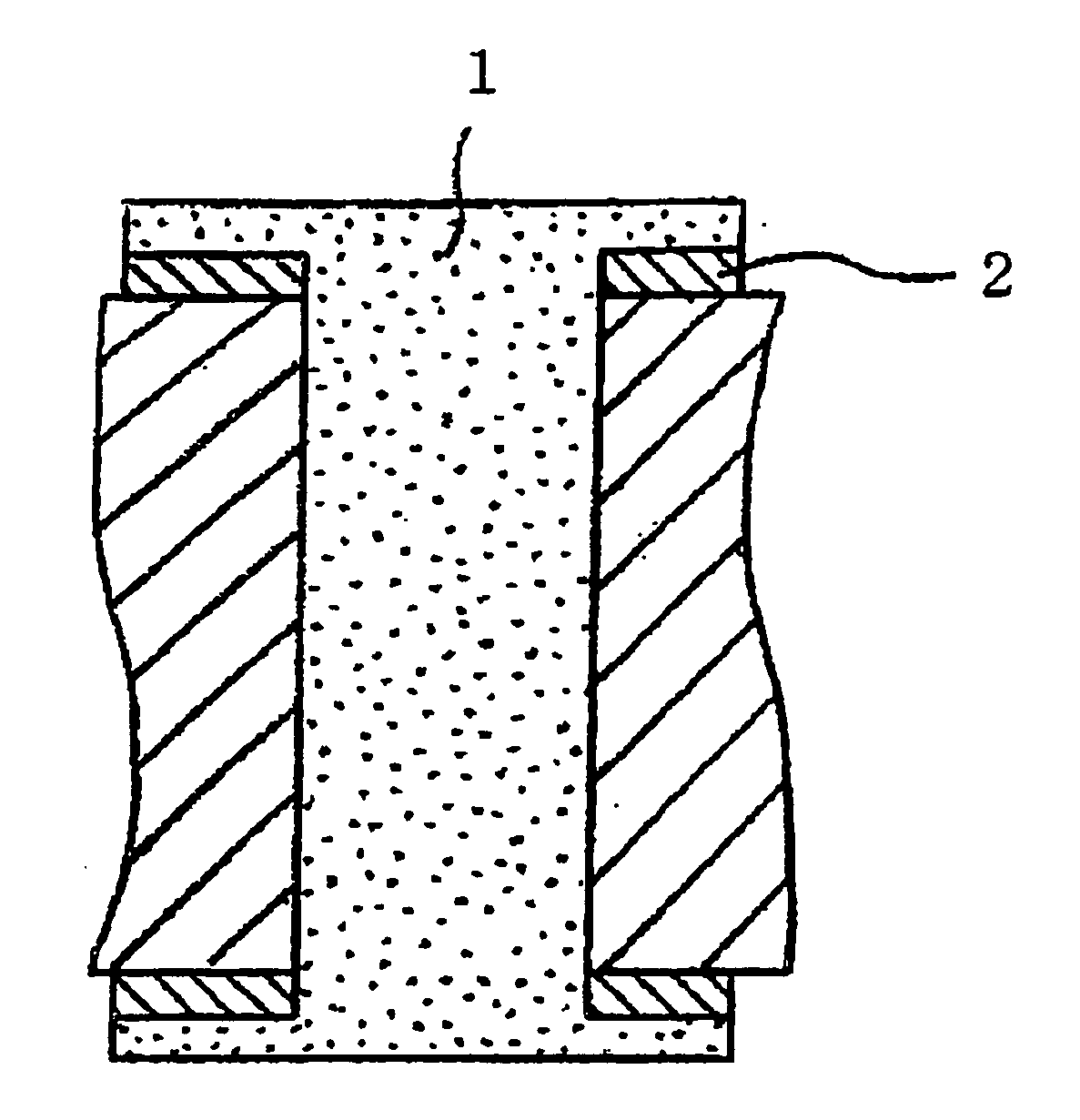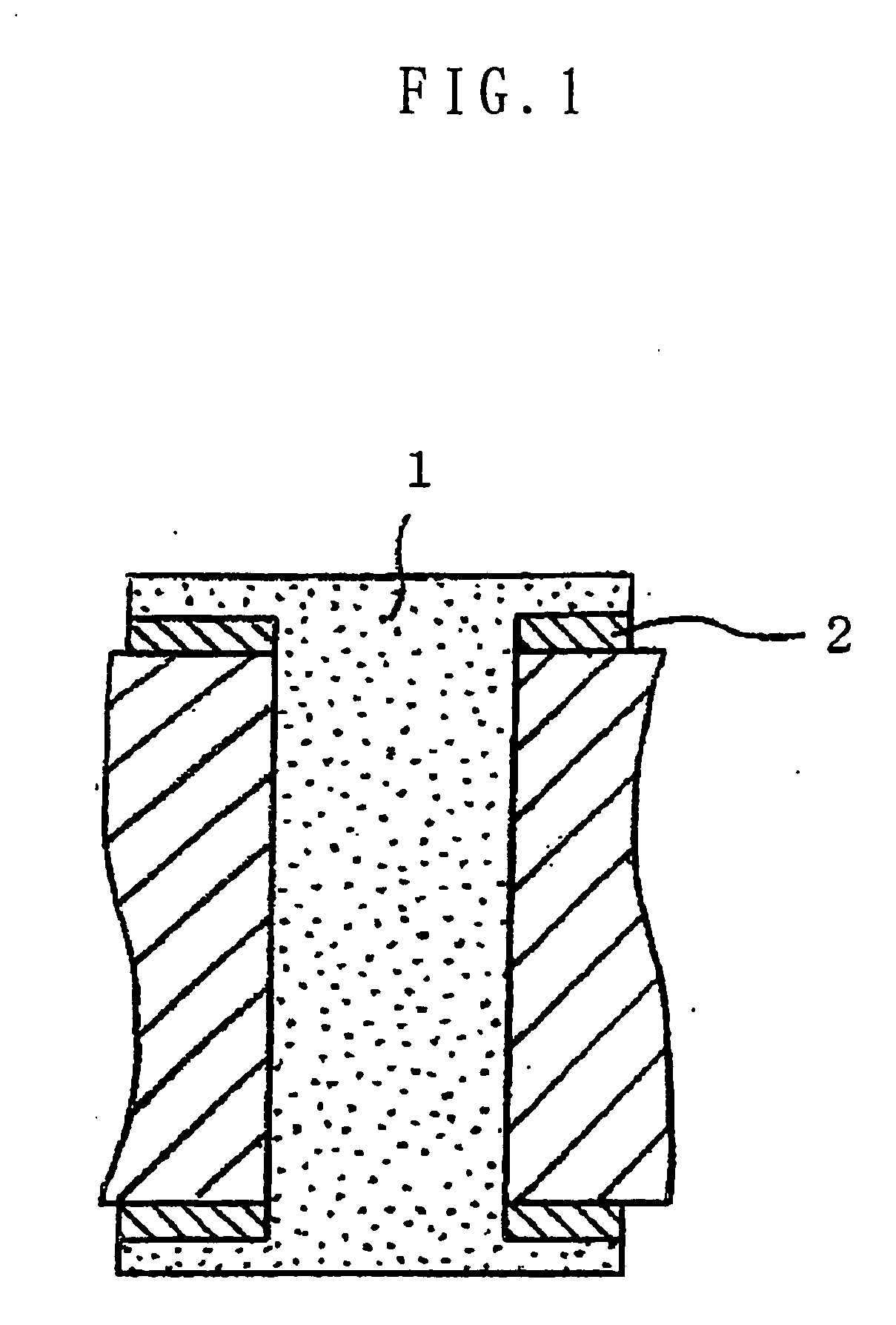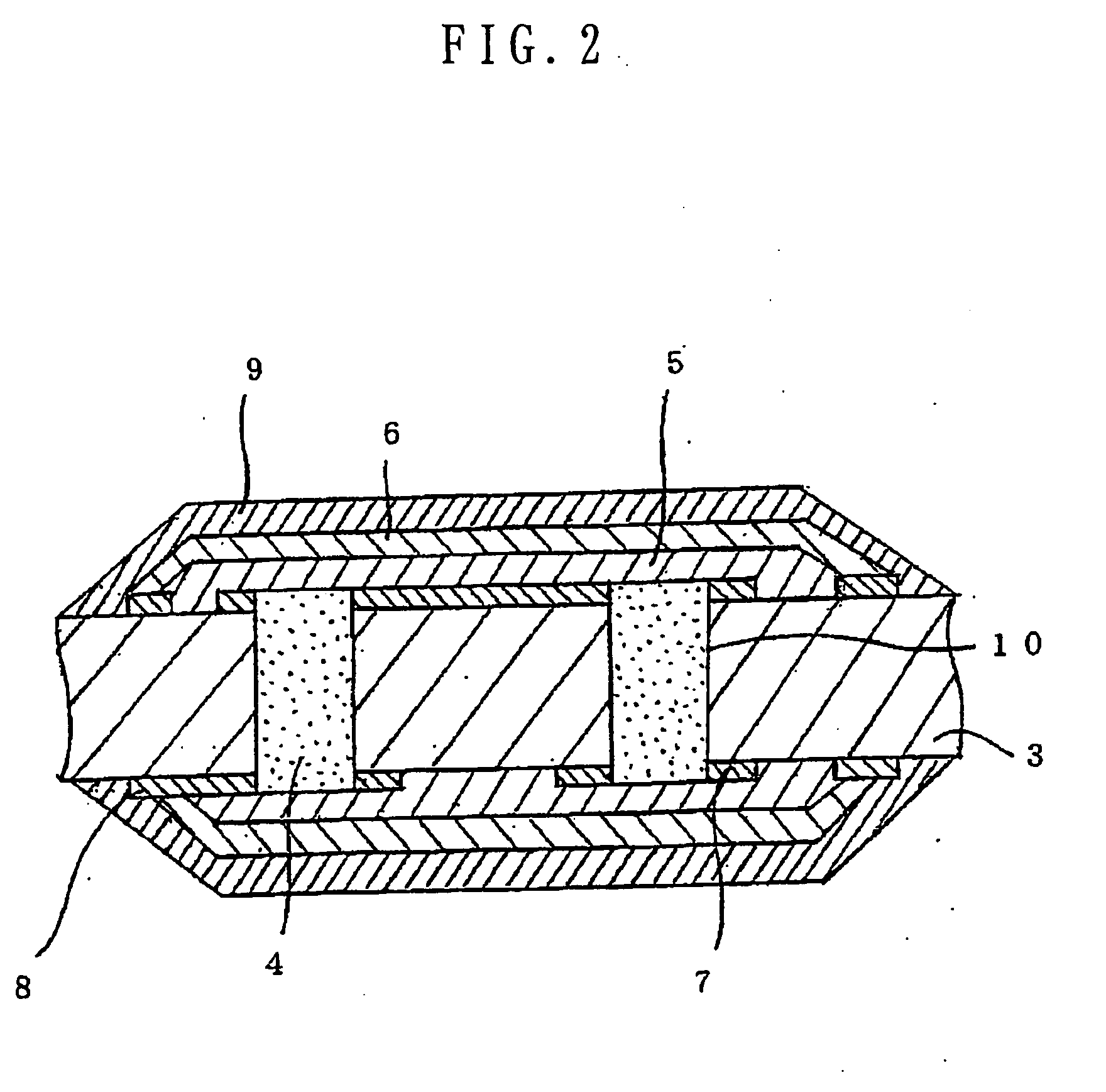Several countermeasures against this migration have been taken, for example,
coating the surface of a conductor with a
moisture-proof
coating or adding a
corrosion inhibitor such as a
nitrogen-containing compound to the electroconductive paste, but none thereof had a sufficient effect.
Although migration resistance can be improved by use of a silver-
palladium alloy powder instead of the silver powder, since silver and
palladium are expensive, the silver-
palladium alloy powder is also expensive, which is a drawback.
Furthermore, in order to obtain a conductor having favorable resistance, it is necessary to increase the amount of silver powder added, and since the silver powder is expensive, the electroconductive paste is correspondingly expensive, which is a drawback.
However, when the surface of a copper powder is coated uniformly and thickly with silver, the effect in improving the migration is not sufficient.
Moreover, a
coating obtained from the electroconductive paste cannot be subjected to direct
soldering, which is a drawback.
Furthermore, when the electroconductive paste employing a silver powder is subjected to
soldering, silver
erosion occurs and a good joint cannot be obtained, which is a drawback.
However, after an electroconductive paste employing a copper powder is heated and cured, the copper is very susceptible to oxidation, and the copper powder reacts with
oxygen contained in air or the binder, thus forming an
oxide film on the surface thereof and thereby greatly degrading the electroconductivity.
In order to overcome this, a copper paste having its electroconductivity stabilized by adding various types of
reducing agent so as to prevent the oxidation of the surface of the copper powder has been disclosed, but the electroconductivity and the stability of the electroconductivity thereof are inferior to those of the
silver paste, and the resistance thereof increases in a high temperature,
high humidity test, etc., which is a drawback.
Furthermore, unless the content of the copper powder in the electroconductive paste is high, stable electroconductivity cannot be obtained.
However, when the content of the copper powder is high, the adhesion might be degraded or the storage stability might be poor, which is a drawback.
Moreover, the coating of the copper paste thus obtained cannot, with a conventional copper paste, be directly soldered onto, which is also a drawback.
Conventionally, when a known electroconductive paste is used as an
adhesive, since electroconductive powders are expensive, the electroconductive paste is also expensive compared with a
solder paste, which is a drawback.
Furthermore, since conventionally known electroconductive pastes cannot have solder directly applied thereon, a coating of the electroconductive paste is subjected to an activation treatment before carrying out
electroless plating, or copper
electroplating is carried out in a plating solution using the coating as a
cathode and the
copper coating obtained by plating is subsequently subjected to
soldering.
However, unless the bonding between the coating and the
copper plating is reliable, it is not practical.
When soldering is carried out, a coating is ideally formed from an electroconductive powder alone, which is then subjected to soldering, but there is the problem that no coating can be formed from an electroconductive powder alone without a binder.
However, there is a restriction on the amount of binder in order to achieve reliability and workability of coating formation; for example, if the proportion of the binder is high, the electroconductive powder, which is a
metal, is covered with the binder, there can be no areas where the solder and the electroconductive powder are in contact with each other, the solder cannot therefore adhere, and the electroconductivity is degraded, which are drawbacks.
However, when the proportion of the electroconductive powder is made high as described above, the
viscosity of the electroconductive paste becomes extremely high, and it becomes difficult to prepare an electroconductive paste, the workability when applying the electroconductive paste is degraded, and since the amount of binder for combining the electroconductive powder particles is small, the strength of the coating is also degraded.
Furthermore, when the paste is used as an electroconductive adhesive, since the adhesion is low, it is not suitable for that use.
In the case of general silver pastes, there is the defect that
drying and curing at high temperature for a short time in a solder
reflow oven easily causes swelling.
Copper pastes also have the defects that curing at high temperature for a short time does not give stable electroconductivity, and in reliability tests such as a constant temperature, constant
humidity test and a gas-phase cooling and heating test, the so-called open circuit, that is, loss of conduction, is observed.
Conversely, when the proportion of binder is made high, the
viscosity decreases and the hole packing properties are therefore improved, but the electroconductivity is degraded, which is a drawback.
However, since the
epoxy resin shrinks less due to
heat curing than a phenolic resin does, it is difficult to lower the resistance of the electroconductive paste containing the
epoxy resin as a main component, which is a drawback.
Although the resistance can be reduced by increasing the proportion of electroconductive powder in the electroconductive paste or by using a
metal powder having high electroconductivity such as silver, the resulting electroconductive paste is expensive.
On the other hand, there is an electroconductive paste containing a phenolic resin as a main component, and although this electroconductive paste has better electroconductivity than that of the electroconductive paste containing the
epoxy resin as a main component, the
viscosity of the electroconductive paste is high and there is a problem in terms of the hole packing properties.
When an electroconductive layer is formed within a through hole using the electroconductive paste, if the electroconductive paste used for filling the through hole contains a large amount of
solvent, voids are inevitably formed within the through hole during
drying of the
solvent.
When a multilayer circuit board is fabricated by making a through hole conduct by means of
copper plating formed on the inner wall of the through hole, after the inner wall of the through hole is subjected to
copper plating, by applying cap plating over the electroconductive paste with which the through hole is filled, the above-mentioned drawbacks can be eliminated, but the number of steps increases and the cost also increases, which is undesirable.
There is also a method in which the inner wall of a through hole is subjected to copper plating so as to form an electroconductive layer, and the cavity is filled with a resin, and this method also has the defect that the number of steps increases and the cost is thus high.
In this method, since the electroconductive material with which the through hole is filled and a
copper foil land portion are connected to each other via the cross section of an end portion of the
copper foil, there is the defect that the reliability of the connection is low.
In order to eliminate this defect, the above-mentioned cap plating may be carried out, but this increases the number of steps and the cost, which is undesirable.
When a multilayer circuit board is fabricated by using a silver through hole wiring board in which a through hole is filled with a silver electroconductive material (
silver paste) containing a
solvent at 15 wt % or more and forming an insulating layer and a printed circuit on the surface of this wiring board, a large cavity is formed within the through hole accompanying
evaporation of the solvent, resulting in a decrease in the reliability.
Furthermore, in the case of the silver through hole wiring board, the
silver paste might be thickly built up on a
copper foil land, and the height of this thick, built up silver paste might obstruct the mounting of components.
However, recently, restrictions on the use of lead have been proposed since lead is highly toxic and the
human body and the
ecosystem might be easily affected when a lead-containing
effluent is treated.
At present, a
low melting point metal brazing material employing, as a substitute for lead, a metal material having a comparatively
low melting point such as
bismuth is being developed, but since the
melting point thereof is higher than that of lead solder, it is necessary to increase the
heat resistance of the substrate material, electronic components to be mounted, etc., giving rise to the defects of technical difficulty, an increase in cost, etc.
However, the conventional hole-filling electroconductive paste employs an epoxy resin as a main component of the binder, and generally uses an
imidazole as a curing agent therefor, and when a substantially spherical silver-coated copper powder that has been subjected to a dispersion treatment to break up aggregates and has copper exposed on the surface thereof is used as an electroconductive powder, the curing properties of the electroconductive paste might be degraded, which is a drawback.
Furthermore, since the substantially spherical silver-coated copper powder easily aggregates in a silver plating step and has a low tap density, if a large proportion thereof is added to the electroconductive paste, the viscosity of the paste is undesirably increased.
Moreover, when the substantially spherical silver-coated copper powder that has been subjected to the dispersion treatment is used, since a resol type phenolic resin forms a chelating bond with the copper, the viscosity of the electroconductive paste increases during storage, which is a drawback.
 Login to View More
Login to View More 


